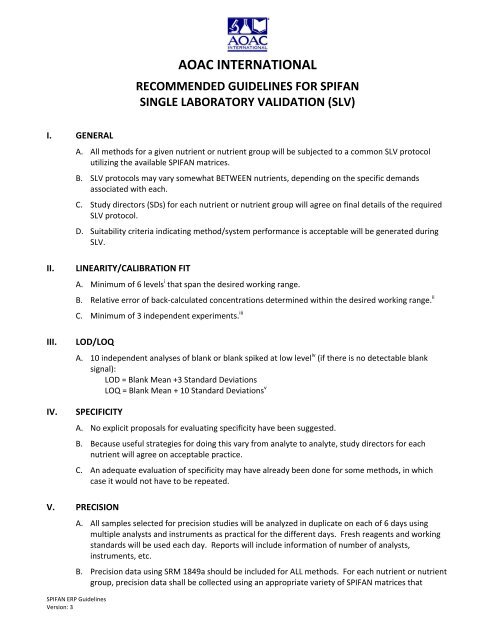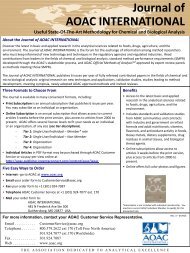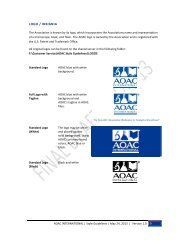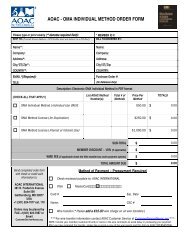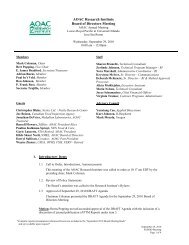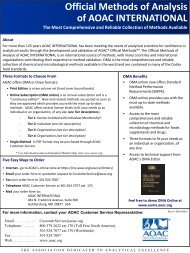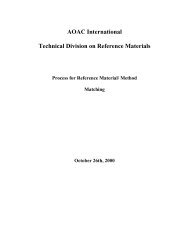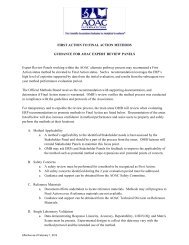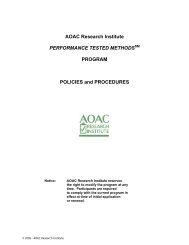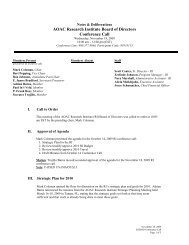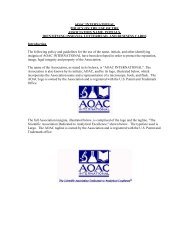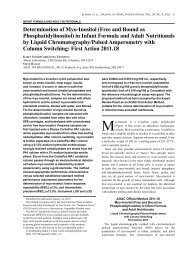(SPIFAN) SLV Guidelines - AOAC International
(SPIFAN) SLV Guidelines - AOAC International
(SPIFAN) SLV Guidelines - AOAC International
You also want an ePaper? Increase the reach of your titles
YUMPU automatically turns print PDFs into web optimized ePapers that Google loves.
<strong>AOAC</strong> INTERNATIONAL<br />
RECOMMENDED GUIDELINES FOR <strong>SPIFAN</strong><br />
SINGLE LABORATORY VALIDATION (<strong>SLV</strong>)<br />
I. GENERAL<br />
A. All methods for a given nutrient or nutrient group will be subjected to a common <strong>SLV</strong> protocol<br />
utilizing the available <strong>SPIFAN</strong> matrices.<br />
B. <strong>SLV</strong> protocols may vary somewhat BETWEEN nutrients, depending on the specific demands<br />
associated with each.<br />
C. Study directors (SDs) for each nutrient or nutrient group will agree on final details of the required<br />
<strong>SLV</strong> protocol.<br />
D. Suitability criteria indicating method/system performance is acceptable will be generated during<br />
<strong>SLV</strong>.<br />
II.<br />
III.<br />
IV.<br />
LINEARITY/CALIBRATION FIT<br />
A. Minimum of 6 levels i that span the desired working range.<br />
B. Relative error of back‐calculated concentrations determined within the desired working range. ii<br />
C. Minimum of 3 independent experiments. iii<br />
LOD/LOQ<br />
A. 10 independent analyses of blank or blank spiked at low level iv (if there is no detectable blank<br />
signal):<br />
LOD = Blank Mean +3 Standard Deviations<br />
LOQ = Blank Mean + 10 Standard Deviations v<br />
SPECIFICITY<br />
A. No explicit proposals for evaluating specificity have been suggested.<br />
B. Because useful strategies for doing this vary from analyte to analyte, study directors for each<br />
nutrient will agree on acceptable practice.<br />
C. An adequate evaluation of specificity may have already been done for some methods, in which<br />
case it would not have to be repeated.<br />
V. PRECISION<br />
A. All samples selected for precision studies will be analyzed in duplicate on each of 6 days using<br />
multiple analysts and instruments as practical for the different days. Fresh reagents and working<br />
standards will be used each day. Reports will include information of number of analysts,<br />
instruments, etc.<br />
B. Precision data using SRM 1849a should be included for ALL methods. For each nutrient or nutrient<br />
group, precision data shall be collected using an appropriate variety of <strong>SPIFAN</strong> matrices that<br />
<strong>SPIFAN</strong> ERP <strong>Guidelines</strong><br />
Version: 3
contain the nutrient or nutrient group (as agreed upon by the SDs). The number of matrices may<br />
vary between nutrients.<br />
C. Estimate within‐day (repeatability), day‐to‐day, and overall (intermediate precision) for each<br />
sample type. Estimates pooled across sample types may also be useful.<br />
VI.<br />
ACCURACY (TRUENESS)<br />
A. Analysis of SRM 1849a<br />
1. Comparison to SRM values may not always be applicable because nutrient definitions are not<br />
aligned. SDs will agree on whether this should be part of the accuracy assessment.<br />
B. Spike Recovery<br />
1. Recovery will be determined from an appropriate sampling of <strong>SPIFAN</strong> matrices. Either<br />
Unfortified (preferably) and/or fully fortified products may be used.<br />
2. Each selected matrix will be spiked at 2 levels. Recommended spike levels are 50 and 150% of<br />
typical target; or 50 and 100% overspikes. SDs will agree on levels used.<br />
3. Spiked and unspiked samples will be analyzed in duplicate on each of 3 days.<br />
4. The overall mean of unspiked samples will be used for computing recoveries.<br />
5. Matrices used for estimating recoveries may or may not coincide with one or more of those<br />
selected for precision studies. If there is overlap, then a single 2x6 replication of the unspiked<br />
matrix covers both requirements for that sample type.<br />
C. Comparison to Reference Methods<br />
1. This is not required as matter of routine, because the additional effort and lack of appropriate<br />
reference methods.<br />
2. SDs may choose to collect reference method comparison data.<br />
i Levels to be agreed upon by SDs.<br />
ii No specific criterion in SMPR. Recommend calibration errors to be


